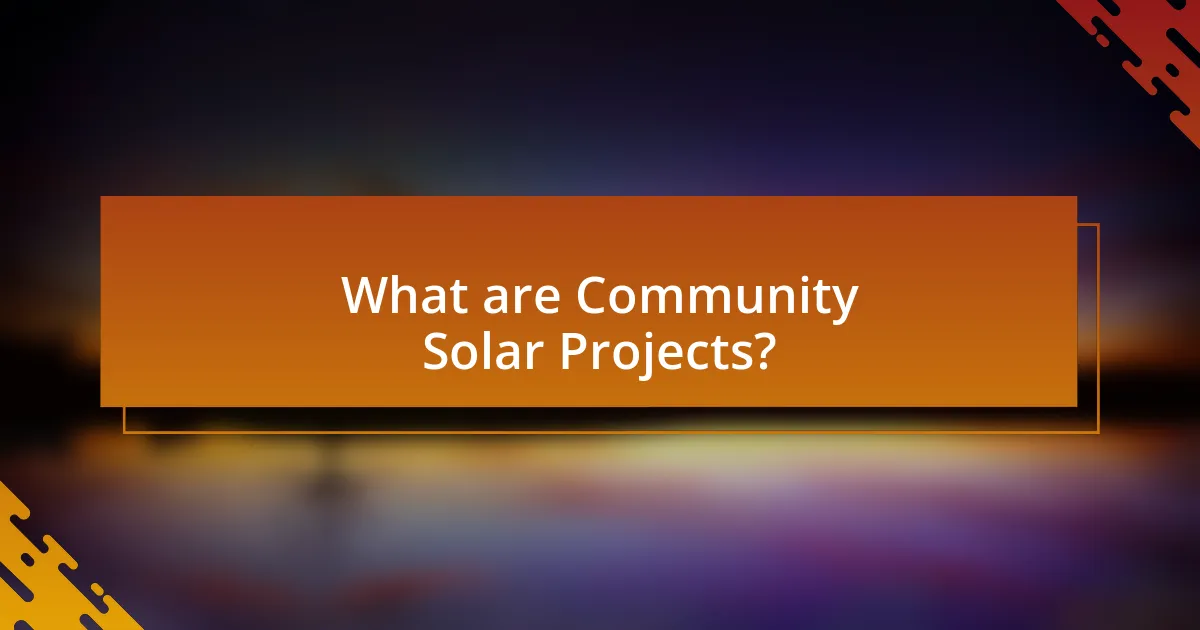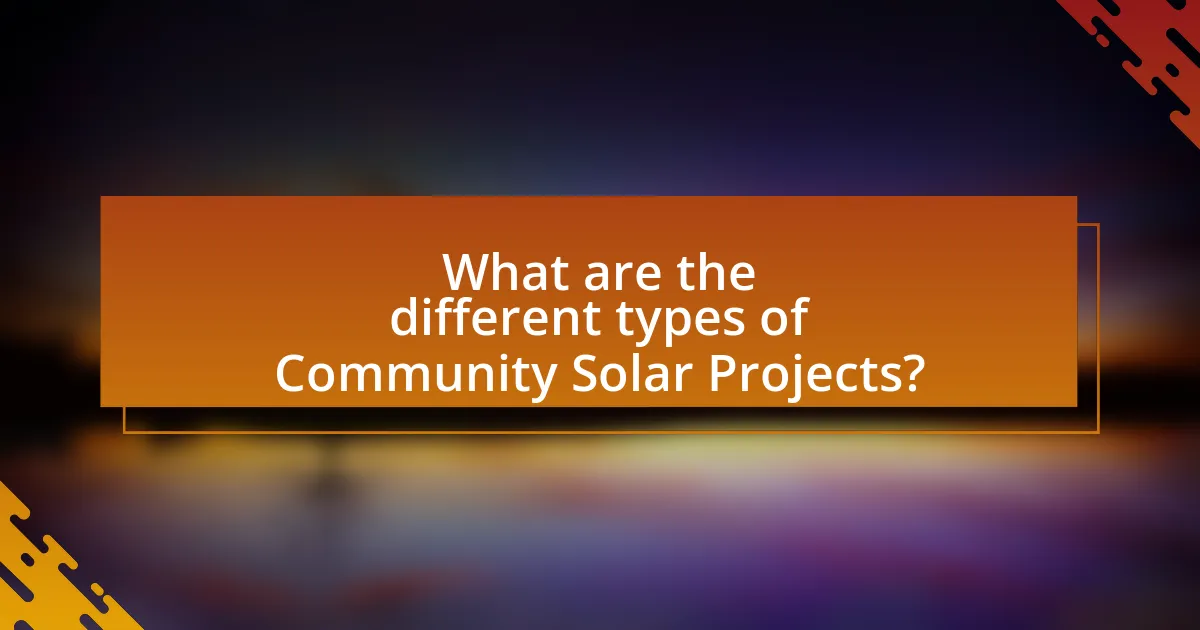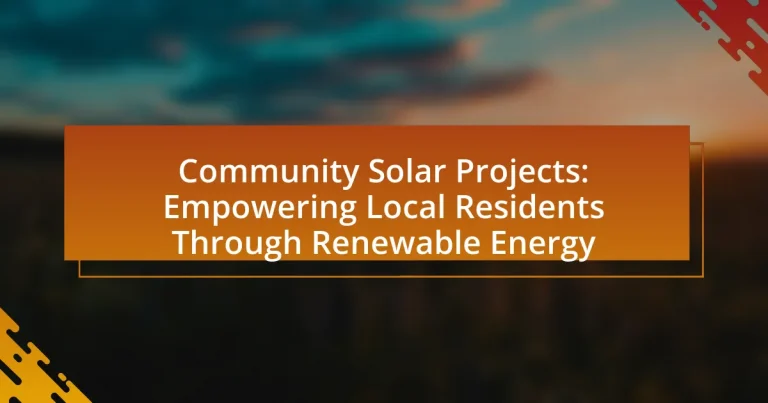Community solar projects are renewable energy initiatives that enable multiple participants, including residents and businesses, to share the benefits of a single solar array. These projects provide access to solar energy for individuals who may not have suitable rooftops for solar panels, such as renters or those with shaded roofs, allowing them to invest in and receive credits for the energy produced. The article outlines the operation of community solar projects, their key components, and the benefits they offer, including reduced energy costs and increased energy equity. It also discusses the different types of community solar projects, the challenges they face, and strategies for successful implementation, emphasizing the importance of community engagement and education in promoting renewable energy adoption.

What are Community Solar Projects?
Community solar projects are renewable energy initiatives that allow multiple participants, often residents or businesses, to share the benefits of a single solar array. These projects enable individuals who may not have suitable rooftops for solar panels, such as renters or those with shaded roofs, to invest in and receive credits for the energy produced by the solar installation. According to the National Renewable Energy Laboratory, community solar can increase access to solar energy, promote local economic development, and support grid resilience by diversifying energy sources.
How do Community Solar Projects operate?
Community solar projects operate by allowing multiple participants to invest in or subscribe to a shared solar energy system, typically located off-site. These projects generate electricity that is fed into the local grid, and participants receive credits on their utility bills based on their share of the energy produced. According to the National Renewable Energy Laboratory, community solar can increase access to renewable energy for those who may not have suitable rooftops for solar panels, thereby promoting wider adoption of clean energy solutions.
What are the key components of Community Solar Projects?
The key components of Community Solar Projects include solar arrays, subscription models, and community engagement. Solar arrays are the physical installations that generate electricity from sunlight, typically located on unused land or rooftops. Subscription models allow local residents to buy or lease a share of the solar energy produced, enabling them to benefit from renewable energy without needing to install solar panels on their own properties. Community engagement is crucial for the success of these projects, as it involves educating residents about the benefits of solar energy and ensuring their participation in decision-making processes. These components work together to create a sustainable energy solution that empowers local communities.
How do participants benefit from Community Solar Projects?
Participants benefit from Community Solar Projects primarily through reduced energy costs and increased access to renewable energy. By subscribing to a community solar program, individuals can receive credits on their electricity bills based on the energy produced by the solar array, leading to savings that can range from 10% to 30% on their monthly utility expenses. Additionally, these projects provide an opportunity for residents who may not have suitable rooftops for solar panels, such as renters or those with shaded properties, to engage in solar energy production. According to a report by the National Renewable Energy Laboratory, community solar projects can increase local energy resilience and contribute to a more sustainable energy grid, further enhancing the benefits for participants.
Why are Community Solar Projects important for local communities?
Community solar projects are important for local communities because they provide access to renewable energy for residents who may not have the means to install solar panels on their own properties. These projects enable collective investment in solar energy, allowing participants to benefit from lower electricity costs and reduced reliance on fossil fuels. According to the National Renewable Energy Laboratory, community solar can increase solar adoption by up to 20% in areas where individual installations are not feasible, thus promoting energy equity and sustainability.
How do they promote renewable energy adoption?
Community solar projects promote renewable energy adoption by providing accessible solar energy solutions to local residents. These initiatives allow individuals to invest in or subscribe to a shared solar array, enabling them to benefit from renewable energy without the need for individual solar panel installations. According to the National Renewable Energy Laboratory, community solar can increase participation in renewable energy by up to 50% among households that cannot install solar panels due to financial, structural, or spatial constraints. This model not only democratizes access to clean energy but also fosters community engagement and awareness about the benefits of renewable energy.
What role do they play in energy equity?
Community solar projects play a crucial role in energy equity by providing access to renewable energy for underserved populations. These projects enable individuals and families who may not have the means to install solar panels on their own properties to benefit from clean energy sources. For instance, according to a report by the National Renewable Energy Laboratory, community solar can reduce energy costs for low-income households by up to 50%, thereby promoting financial savings and energy independence. Additionally, these initiatives foster local job creation and community engagement, further enhancing social equity within energy systems.

What are the different types of Community Solar Projects?
Community solar projects can be categorized into three main types: shared solar, community-owned solar, and virtual net metering solar. Shared solar projects allow multiple participants to invest in a single solar installation, benefiting from the energy produced. Community-owned solar projects are developed and owned by local residents or organizations, ensuring that profits and benefits remain within the community. Virtual net metering solar projects enable participants to receive credits on their utility bills for energy produced by a remote solar installation, even if they do not have direct access to the solar panels. These classifications highlight the diverse approaches to community solar, promoting local engagement and renewable energy access.
How do subscription-based models work in Community Solar Projects?
Subscription-based models in Community Solar Projects allow individuals or businesses to purchase a share of a solar energy system, enabling them to benefit from renewable energy without needing to install solar panels on their property. Participants pay a monthly fee or a one-time upfront cost for their subscription, which corresponds to a portion of the energy produced by the solar array. This model democratizes access to solar energy, making it available to those who may not have suitable roofs or the financial means to invest in solar technology directly. According to the National Renewable Energy Laboratory, community solar programs can increase solar adoption by providing flexible options for consumers, thus expanding the market for renewable energy.
What are the advantages of subscription-based Community Solar Projects?
Subscription-based Community Solar Projects offer several advantages, including increased accessibility to renewable energy, cost savings, and community engagement. These projects allow individuals and businesses to subscribe to a portion of a larger solar installation, making solar energy available to those who may not have suitable rooftops or the financial means to install their own systems. According to the National Renewable Energy Laboratory, community solar can reduce energy costs by up to 10% for subscribers, providing a financial incentive for participation. Additionally, these projects foster local involvement and investment in renewable energy, enhancing community ties and promoting sustainability.
What challenges do subscription-based models face?
Subscription-based models face challenges such as customer retention, pricing competition, and service differentiation. Customer retention is critical, as studies show that acquiring new subscribers can cost five times more than retaining existing ones. Pricing competition arises from the need to offer attractive rates while maintaining profitability, especially in markets with numerous alternatives. Service differentiation is essential to stand out in a crowded market; without unique offerings, subscription services risk becoming commoditized, leading to higher churn rates. These challenges necessitate strategic approaches to enhance value and engagement for subscribers.
What are community-owned solar initiatives?
Community-owned solar initiatives are renewable energy projects where local residents collectively own and manage solar energy systems. These initiatives enable communities to harness solar power, reduce energy costs, and promote sustainability. For instance, a study by the National Renewable Energy Laboratory found that community solar projects can increase access to solar energy for individuals who may not have suitable rooftops or financial means to install their own systems. This model fosters local engagement and investment in renewable energy, contributing to energy independence and environmental benefits.
How do community-owned projects differ from other models?
Community-owned projects differ from other models primarily in their governance structure and stakeholder engagement. In community-owned projects, local residents have direct ownership and decision-making power, which fosters a sense of collective responsibility and investment in the project’s success. This contrasts with traditional models, where projects may be owned and operated by private entities or government bodies, often leading to decisions that prioritize profit over community needs. For instance, community solar projects allow residents to collectively invest in renewable energy, ensuring that the benefits, such as reduced energy costs and environmental sustainability, are shared among local participants rather than external shareholders. This model has been shown to enhance community resilience and promote social equity, as evidenced by successful initiatives in various regions that have increased local energy access and participation in renewable energy generation.
What are the benefits of community ownership in solar energy?
Community ownership in solar energy provides several benefits, including increased local economic development, enhanced energy independence, and improved social equity. Local economic development occurs as community members invest in and benefit from solar projects, leading to job creation and local revenue generation. Enhanced energy independence is achieved as communities reduce reliance on external energy sources, fostering resilience against energy price fluctuations. Improved social equity is evident as community ownership allows diverse participation, ensuring that low-income households and marginalized groups can access renewable energy benefits. Studies show that community solar projects can lead to a 20% reduction in energy costs for participants, demonstrating the tangible financial advantages of community ownership in solar energy.

What challenges do Community Solar Projects face?
Community Solar Projects face several significant challenges, including regulatory hurdles, financing difficulties, and community engagement issues. Regulatory hurdles arise from varying state policies and interconnection standards, which can complicate project development and implementation. Financing difficulties often stem from the need for substantial upfront capital, which can deter potential investors. Additionally, community engagement issues can arise when residents are not adequately informed or involved in the project, leading to resistance or lack of participation. These challenges can hinder the successful deployment and operation of community solar initiatives, impacting their overall effectiveness in promoting renewable energy access.
How do regulatory barriers impact Community Solar Projects?
Regulatory barriers significantly hinder the development and implementation of Community Solar Projects by imposing restrictions that limit access to financing, interconnection, and market participation. These barriers can include complex permitting processes, restrictive zoning laws, and inadequate policies that fail to support shared solar initiatives. For instance, a report by the National Renewable Energy Laboratory indicates that states with supportive regulatory frameworks see a higher rate of community solar installations, while those with stringent regulations experience slower growth. This demonstrates that the presence of regulatory barriers directly correlates with the feasibility and attractiveness of community solar projects for local residents and investors.
What are common regulatory hurdles for these projects?
Common regulatory hurdles for community solar projects include interconnection agreements, permitting processes, and compliance with state and federal regulations. Interconnection agreements can delay project timelines as they require coordination with utility companies to ensure that the solar energy generated can be integrated into the existing grid. Permitting processes often involve navigating local zoning laws and environmental assessments, which can vary significantly by location and may lead to additional costs or project modifications. Compliance with state and federal regulations, such as those related to energy production and consumer protection, can also pose challenges, as these regulations may change and require ongoing adjustments to project plans.
How can communities overcome these barriers?
Communities can overcome barriers to community solar projects by fostering collaboration among stakeholders, securing funding, and enhancing public awareness. Collaborative efforts between local governments, non-profits, and private sector partners can streamline project development and address regulatory challenges. For instance, the Solar Energy Industries Association reported that partnerships can reduce costs and improve project viability. Additionally, communities can access grants and incentives from federal and state programs, which can alleviate financial constraints. Public awareness campaigns can educate residents about the benefits of solar energy, increasing participation and support. Research from the National Renewable Energy Laboratory indicates that informed communities are more likely to engage in renewable energy initiatives, thus overcoming barriers effectively.
What financial challenges do Community Solar Projects encounter?
Community Solar Projects encounter several financial challenges, including high initial capital costs, fluctuating energy prices, and difficulties in securing financing. The high upfront investment required for solar infrastructure can deter potential investors and limit project feasibility. Additionally, the variability in energy prices can affect revenue projections, making it challenging to attract long-term financial commitments. According to a report by the National Renewable Energy Laboratory, approximately 60% of community solar projects struggle to secure adequate financing due to these factors, which can hinder their development and sustainability.
How do funding and investment affect project viability?
Funding and investment are critical determinants of project viability, particularly in community solar projects. Adequate funding ensures that necessary resources, such as technology, infrastructure, and operational costs, are available, which directly influences the project’s ability to launch and sustain operations. For instance, a study by the National Renewable Energy Laboratory found that projects with robust financial backing are 50% more likely to succeed compared to those with limited funding. Additionally, investment attracts expertise and innovation, enhancing project efficiency and effectiveness. Therefore, the availability and management of funding and investment fundamentally shape the success and longevity of community solar initiatives.
What strategies can be employed to secure funding?
To secure funding for community solar projects, organizations can employ strategies such as forming partnerships with local governments, leveraging grants, and engaging in crowdfunding initiatives. Partnerships with local governments can provide access to public funding sources and enhance project credibility, as evidenced by the Solar Energy Industries Association’s report indicating that government-backed projects often receive higher funding levels. Additionally, applying for grants from foundations and federal programs, such as the U.S. Department of Energy’s Solar Energy Innovation Network, can provide substantial financial support. Crowdfunding platforms, like SeedInvest, have also been successful in raising capital for renewable energy projects, demonstrating community interest and investment potential.

How can communities successfully implement Community Solar Projects?
Communities can successfully implement Community Solar Projects by establishing clear goals, engaging stakeholders, securing financing, and ensuring regulatory compliance. Clear goals help define the project’s scope and objectives, while stakeholder engagement fosters community support and participation, which is crucial for project success. Securing financing through grants, loans, or partnerships with private investors provides the necessary capital for installation and maintenance. Additionally, understanding and adhering to local regulations and policies ensures that the project meets legal requirements and can operate effectively. For instance, a study by the National Renewable Energy Laboratory found that community solar projects with strong local engagement and clear financial structures are more likely to succeed, demonstrating the importance of these factors in implementation.
What best practices should communities follow when starting a project?
Communities should conduct thorough stakeholder engagement when starting a project. Engaging local residents, businesses, and organizations ensures that diverse perspectives are considered, fostering a sense of ownership and support for the project. Research indicates that projects with strong community involvement are 30% more likely to succeed, as they align with the needs and values of the community. Additionally, establishing clear goals and objectives from the outset helps guide the project and measure its success effectively.
How can community engagement enhance project success?
Community engagement enhances project success by fostering local support and ensuring that the project aligns with community needs. Engaged communities are more likely to participate actively, which can lead to increased funding, volunteer efforts, and advocacy for the project. For instance, a study by the National Renewable Energy Laboratory found that community involvement in solar projects can increase project acceptance rates by up to 50%, demonstrating that when residents feel included, they are more likely to support and promote the initiative. This alignment not only improves project outcomes but also builds long-term relationships between project developers and the community, leading to sustainable success.
What role does education play in the implementation process?
Education plays a crucial role in the implementation process of community solar projects by equipping local residents with the knowledge and skills necessary to engage effectively in renewable energy initiatives. Through educational programs, residents learn about the benefits of solar energy, the mechanics of solar technology, and the financial implications of participating in community solar projects. For instance, studies have shown that informed communities are more likely to adopt renewable energy solutions, as evidenced by a report from the National Renewable Energy Laboratory, which found that education increases participation rates in solar programs by up to 30%. This knowledge empowers residents to make informed decisions, advocate for their interests, and contribute to the successful deployment of community solar initiatives.
What resources are available for communities interested in Community Solar Projects?
Communities interested in Community Solar Projects can access various resources, including government programs, nonprofit organizations, and online platforms. The U.S. Department of Energy offers the Solar Energy Technologies Office, which provides funding opportunities and technical assistance for solar projects. Additionally, organizations like the National Renewable Energy Laboratory and the Solar Energy Industries Association offer guides and best practices for developing community solar initiatives. Online platforms such as the Community Solar Hub provide tools and resources for project planning and implementation. These resources support communities in navigating the complexities of establishing and managing community solar projects effectively.
How can local governments support Community Solar initiatives?
Local governments can support Community Solar initiatives by implementing policies that facilitate the development and financing of solar projects. These policies may include zoning regulations that allow for solar installations, providing incentives such as tax credits or grants, and establishing streamlined permitting processes to reduce bureaucratic hurdles. For instance, a study by the National Renewable Energy Laboratory found that states with supportive policies saw a 50% increase in community solar projects compared to those without such measures. By actively promoting these initiatives, local governments can enhance access to renewable energy for residents, particularly those who may not have the means to install solar panels on their properties.
What organizations provide assistance and funding for these projects?
Organizations that provide assistance and funding for community solar projects include the U.S. Department of Energy, which offers grants and technical support through initiatives like the Solar Energy Technologies Office. Additionally, the National Renewable Energy Laboratory provides research and resources to facilitate project development. Nonprofit organizations such as the Solar Energy Industries Association advocate for policies and funding opportunities, while state-level programs often allocate funds specifically for community solar initiatives. These entities collectively enhance the viability and implementation of renewable energy projects at the community level.
What are the key takeaways for communities considering Community Solar Projects?
Communities considering Community Solar Projects should prioritize collaboration, financial feasibility, and regulatory compliance. Collaboration among local stakeholders, including residents, government, and energy providers, enhances project success by ensuring diverse input and support. Financial feasibility is crucial; communities must assess costs, funding options, and potential savings for participants, as studies show that community solar can reduce energy bills by 10-15%. Regulatory compliance is essential to navigate local laws and incentives, which can significantly impact project viability. For instance, states with supportive policies have seen a 20% increase in community solar installations.


